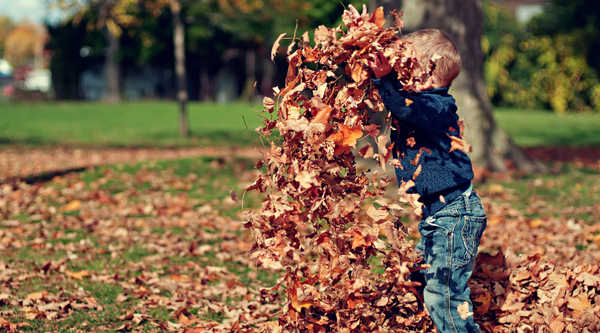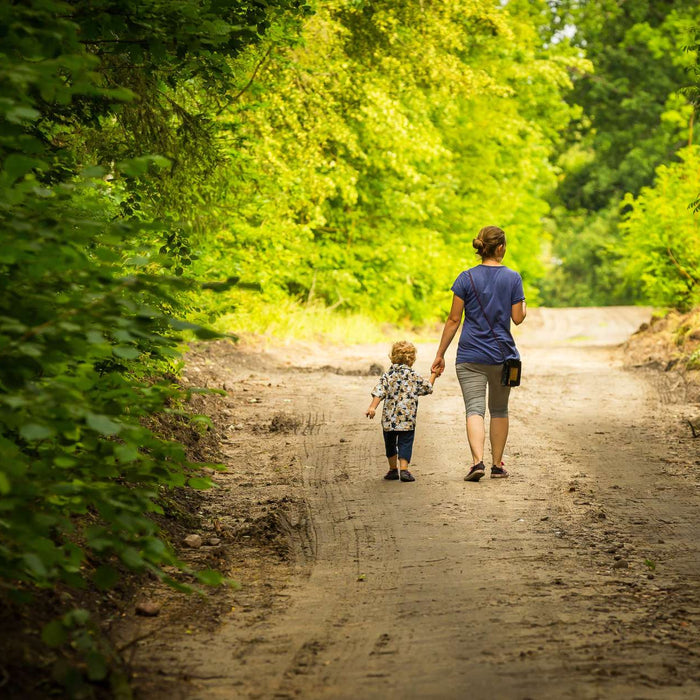Transitioning from Summer into Autumn is the ultimate sensory experience for children and adults alike. You can hear the crunch of the leaves as you walk on them, smell the rain soaked ground, see the colours of the trees and flowers change, taste the seasonal food (apple crumble, gingerbread cookies), feel and touch the dew that lands overnight.
Nature is one of the simplest tool we can use to ground ourselves, to breathe and self-regulate. Aistear highlights the importance of our natural environment as it instills a natural curiosity in children to question and find out how and why all of these changes are happening. We can give children a sense of belonging by using nature and the outdoor environment in our teaching to show them how we are all connected. Finding out ways that we can help to support nature by planting flowers, trees, having shaded areas and water for animals, birds and insects to access will show the children how they can impact and care for our world by making small changes.

Here are 7 Autumn activities you can carry out in your classroom, with our Yellow Door range, to explore the wonders of nature that happen in Autumn. These activities can also be adapted to use at home too.
Go on an outdoor adventure with this Guided Nature Hunt
Get your Yellow Door Shape Viewers and Discovery Playtime Autumn Nature Hunt printable and go outside with the children to see how many items you can tick off the list. You can pair the children up and give each pair a special task. For example, find all of the square objects in the garden (if they have the square shape finder), only collect items that are small enough to fit inside your shape finder. After you have found as many items in your area that you need, bring them into your classroom and get each child to pick 1 item that they can share with the group. You can use this time to ask prompting questions to find out what the children already know vs what they would like to know about the materials and their outdoor environment.
This activity will encourage:
- Pre-numeracy skills- recognising shapes and patterns, spacial awareness
- Gross motor skills
- Team-work and turn taking
- Communication
- Intrinsic motivation
- Critical thinking
Embrace nature with loose parts made from natural materials
Children can connect with materials and objects when they can freely and openly play and explore them in their own time and unique way. After you have collected the natural materials outside you can arrange them in our Yellow Door Tinker Tray to have them on display and readily accessible whenever the children may want to look at them, touch them, smell them or simply add them into their play. Natural materials are great loose parts as they are open-ended and don't need to be used a certain way so the children can imagine them to be anything that their imagination needs. For example, sticks can be used to make a campfire and the conkers can be people attending the campfire or food to cook on the fire.
 This activity will encourage:
This activity will encourage:
- Decision-making, creativity and imagination
- Respecting and caring for the environment
- Pre-numeracy skills- sorting, patterns, predicting, sequencing
- Take control of their own learning
- Fine motor and dexterity
- Hand-eye co-ordination
Get creative with the Yellow Door rollers in your homemade sensory playdough
Make scented playdough with the children by adding in cinnamon/ginger powder or a few drops of any essential oil you prefer or that the children choose. When the playdough is made place the Yellow Door 10 frame rollers on the table. There are 6 rollers in the pack which can create a 1-5 number frame, 1-10 number frame, a beanstalk, stepping stones, bird boxes and train carriages. Each of these rollers can support early numeracy skills through free play and guided activities. Add in conkers/pine cones/ bottle tops/loose parts to create the need for sorting, counting, pattern making and sequencing. These Yellow Door rollers can print in any malleable material such as playdough, mad mattr, wet send, magic sand, cloud dough, soil and so much more.

This activity will encourage:
- Decision making
- Fine motor skills and dexterity
- Self-regulation
- Numeracy and counting
- Pre-numeracy skills- sequencing, patterns, sorting
- Communication and vocabulary
- Peer learning
Let's paint with Let's Roll Forest Friends
Place tuff tray paper insert into your tuff tray. Add in some bowls of paint and add a few drops of paint onto the paper too. Have some paint brushes, rollers and the outdoor natural materials you collected nearby. Roll your Forest Friends rollers through the paint and watch the images sweep across the page. Use a paint brush to brush paint onto the roller and stamp it onto the paper. The children can paint, stamp, roll and create patterns using the rollers in the paint. You can then add in your natural materials- leaves, flowers, conkers, and try and match them to the paintings. Can you paint with/on the leaves and print them? You can extend this activity to getting the children to wash the items after they are finished in soapy water to create the responsibility for looking after our classroom and resources

This activity will encourage:
- Confidence to express themselves
- Self-regulation
- Care of their classroom and environment
- Matching and sorting
- Fine motor skills, hand-eye co-ordination and dexterity
- Communication
Exploring the change in weather- how it affects our environment
'There is no such thing as bad weather, just unsuitable clothing'. The change of weather in Ireland is inevitable so instead of complaining and letting it create a barrier why not use it as a learning opportunity. How does our environment adapt to weather? Some flowers close their petals to protect themselves from the rain. What can we do to adapt to the weather? What can we use to protect us from the rain? Use our Wonderfully Weather books David Drizzledrop and the Puddle Party and Yellow Door Weather Stones to introduce the topic of the weather and ask the children what the weather was like when they came to school that morning.

If you have a mud kitchen, great, if you don't just make your own simple and easy mud kitchen by bringing out some pots, pans, spoons and fine motor tools into your outdoor space. If you want to keep it contained you can use your tuff tray as a boundary. Add in some muck/soil/stones/grass/leaves and leave jugs of water beside them. The children can explore the different textures/scents when they add in the water to their messy base. If you need some inspiration add in a few of our waterproof Yellow Door Mud Kitchen Activity cards for some visual and vocabulary prompts and enriching text in the environment.

This activity will encourage:
- Confidence to express themselves
- Independence in decision-making
- Self-regulation
- Capacity and numeracy skills
- Hand-eye co-ordination and dexterity
- Predicting, questioning and negotiation
- Caring for the environment
Discover the fascinating world of Bugs and Insects nearby!
Use the
Yellow Door Bug Stones as a prompt to get the children to think about where bugs may live. Name out each bug on the stones, pass them around to the children, try to name all the bugs and guess where they live and what they eat. I wonder what bugs live in our garden? Take your
shape viewers or
magnifiers and go out into your garden to search for bugs. Try to name it, see where it's going, what it's eating. If you can take some pictures of the bugs, insects and areas that you find them in. If you can, print the pictures you have taken and have them in the classroom (maybe low on a wall or in the arts and crafts area so the children can access them). If there were some bugs you didn't know the name for spend time with the children learning how to find the information.
Can we look it up in a book? Do we need to use google? How do we describe the bug?

This activity will encourage:
- Understanding and learning their natural environment
- Spacial awareness, size, matching, comparing
- Communication and extending vocabulary
- Internet safety and learning to find information
- Turn-taking and non-verbal communication
- Feeling a sense of belonging
Let them explore their creativity with forest sensory habitats
Set up a forest sensory tray with a sensory base of your choosing, oats/rice/lentils/corn/pasta. Add in our
Yellow Door Play Cave,
fine motor tools- tongs/tweezers/scoops/spoons,
sorting bowls and some leaves/twigs/conkers. Give children the opportunity to be part of the play set-up by asking the children what animals they think you should add into the forest. Be open to adding in other items that the children suggest such as blocks to build a home for an animal or some recycled materials such as egg cartons and bottles to be filled, emptied, poured, etc.

This activity will encourage:
- Communication and new vocabulary
- Decision-making and feeling part of the group
- Gross and fine motor skills, hand-eye co-ordination
- Team-work, respecting other people's decisions and play
- Curiosity and self-regulation
- Confidence and intrinsic motivation.














Leave a comment